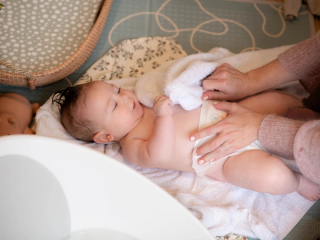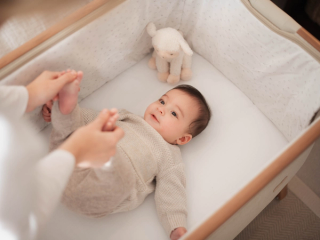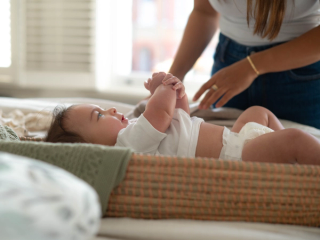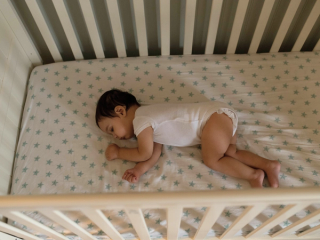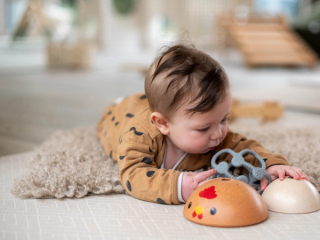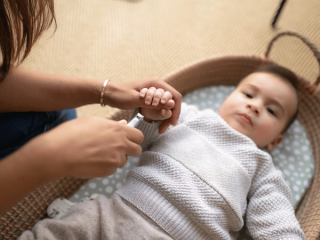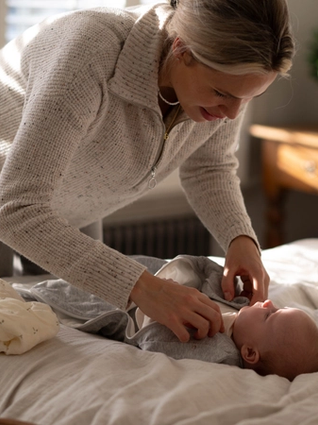
- Home
- Advice Hub
- Newborn
- Essential Newborn Care
- How To Swaddle A Baby Safely
How to swaddle a baby
Our resident sleep expert, Laura, shares her expertise on why it is important to swaddle a baby, a step-by-step guide to swaddling and when to stop.
During the first 3 months with your new born, swaddling can be an extremely helpful tool to help your baby settle to sleep and sleep more soundly. Swaddling is the practice of gently wrapping your baby in a light breathable blanket. During the fourth trimester your baby is adjusting to the outside world and looking for the comfort of that womb-like environment. This is why new-borns so love to be held, rocked and cuddled and do that adorable new born ‘scrunch’ with their bodies! Swaddling your baby will help recreate the snug, comforting environment of the womb as well as mimicking the soothing touch they take such comfort in when cradled by their parents.
During these first few months your baby has a ‘Moro’ reflex also known as the startle reflex. This is entirely normal and healthy; however it can disrupt their sleep when they are placed down into the cot or when their arms move around during sleep. Swaddling helps to avoid this happening as your baby is wrapped securely.
Babies can be swaddled from birth using a stretchy, breathable swaddling blanket.
Here is your step-by-step guide to swaddling your baby:
- Start by laying your blanket on a flat surface in a diamond shape.
- Fold the top corner of the blanket down so that the blanket is folded in half, creating a triangle shape
- Put your baby onto the blanket in the centre with their head sitting above the straight edge
- Bring the left corner of the blanket across your baby’s body, ensuring their arm isn tucked inside and tuck the blanket under their arm and body on the opposite side.
- Bring the bottom corner up and over the right shoulder tucking the blanket under at the shoulder
- Take the right side of the blanket across and wrap completely under and around your baby
- Tuck remaining fabric in at the top
Safety checks
- Ensure the swaddle is not above baby’s shoulders – the blanket should not cover their face or neck
- Ensure your baby is able to move their hips and knees. Your baby’s legs should be able to sit naturally in a ‘frog leg’ position – this reduces the chance of hip dysplasia.
- Check the room temperature and ensure your baby is dressed appropriately for the temperature so that they do not overheat. (16-20°C is a comfortable room temperature for sleeping babies.)
- Do not swaddle your baby if they have a temperature or when bed-sharing.
- Ensure the blanket used is appropriate for swaddling, it should be thin and breathable. If you’re not sure, hold it up to your face and check if you can easily breathe through it.
- If you are using a swaddle product ensure it is the correct tog for the room temperature and is the correct size for your baby’s age and weight.
- Always place your baby on their back to sleep.
When to stop swaddling
From 12 weeks of age you should no longer swaddle your baby. At this point, they are ready to begin to discover their own comfortable position for sleep, so need to have the freedom to move their body around and have access to their hands, which they may choose to use to soothe themselves.
You must stop swaddling your baby when they begin to show signs of rolling. This can happen as early as 6 -7 weeks old. Swaddling once your baby is able to roll is no longer safe and increases the risk of SIDS (sudden infant death syndrome) and suffocation.
If your baby has not shown signs of rolling by 8 weeks old, I recommend starting to transition your baby out of their swaddle in preparation. Babies born early may need to wait a little closer to 12 weeks to begin transitioning out of the swaddle.
Before beginning this transition ensure you have introduced some other positive sleep associations that will help calm your baby when they are no longer able to be swaddled. Setting up their routines and sleep environment for sleep success is going to be instrumental in ensuring the transition goes smoothly.
Some tips include:
- Creating a calming and non-stimulating sleep space. Minimise toys on display and ensure there are no light projectors or mobiles, which could be distracting.
- Ensure the room can be dark for your baby’s sleep times, use blackout blinds and aim for at least an 8 out of 10 on the darkness scale! If you do need to have a small night light opt for a dim red light which will not interfere with the production of the sleep hormone melatonin.
- Use white noise for your baby’s naps and during the night. This will create a calm environment and help buffer external noises disturbing baby.
- Begin giving your baby some opportunities to settle to sleep in the cot. Some babies can do this happily by themselves and others need support! Try settling them in the cot using your reassuring touch and voice. If they are not calming, that’s OK – pick them up and try again for the next sleep.
Start by swaddling your baby with one arm left outside of the swaddle so they can begin to adjust to these new sensations and find a comfortable position for their free arm. After a couple of nights you can leave both arms outside of the swaddle and finally completely remove the swaddle and move your baby to a well-fitting sleeping bag with a TOG appropriate to the room temperature. Note that if your baby shows signs of rolling at any time during this transitional period you must stop swaddling.
Advice & tips

Want to read more? Join the HiPP BabyClub for full access to this article.
As a BabyClub member, you'll get access to a range of exclusive benefits, including:
Monthly competitions
Discounts from our Partners
Expert advice tailored to your little one's age
Weaning recipes
HiPP shop discounts*
*10% off HiPP's online shop does not apply to our First Infant, Anti-Reflux or Comfort Formula Milk.
Important notice: Breastfeeding is best. Follow on milk should only be used as part of a mixed diet from 6 months. Talk to a healthcare professional.





